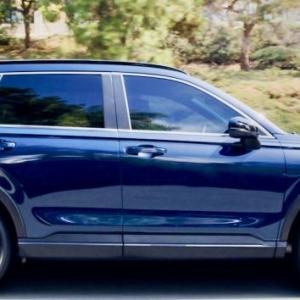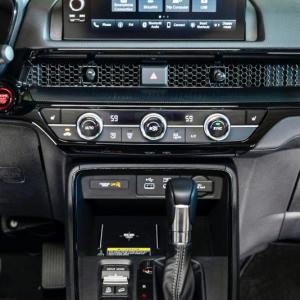Honda CR-V Hybrid AWD Sport Touring
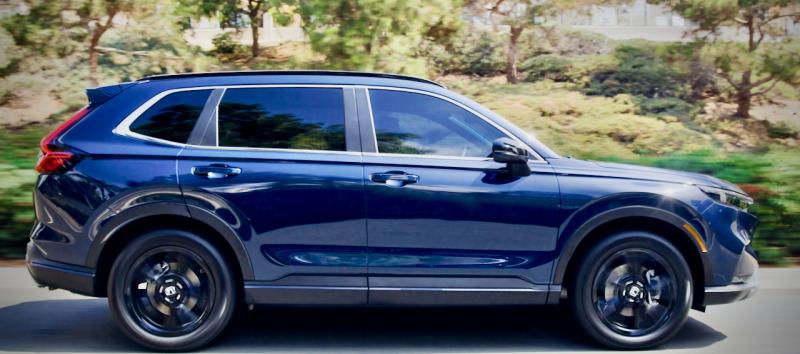 For 2023, Honda unveiled the 6th generation of the CR-V—slightly larger and much roomier, more refined, quicker and better-handling, and with “normalized” hybrid options. This color is Canyon River Blue.
For 2023, Honda unveiled the 6th generation of the CR-V—slightly larger and much roomier, more refined, quicker and better-handling, and with “normalized” hybrid options. This color is Canyon River Blue.
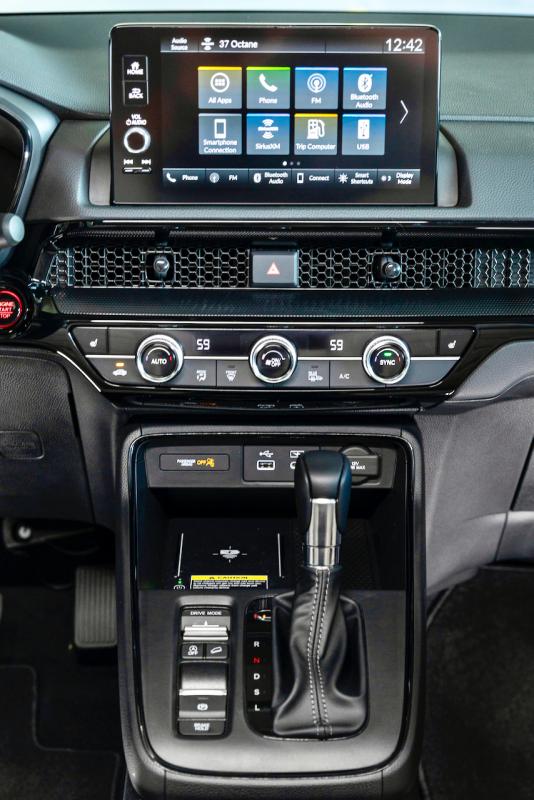 Inside, the new CR-V is pure Honda—highly space-efficient, well-sorted ergonomically, with plenty of storage spaces and featuring surfaces that look and feel good. This is the Sport Touring’s 9-inch touchscreen.
Inside, the new CR-V is pure Honda—highly space-efficient, well-sorted ergonomically, with plenty of storage spaces and featuring surfaces that look and feel good. This is the Sport Touring’s 9-inch touchscreen.
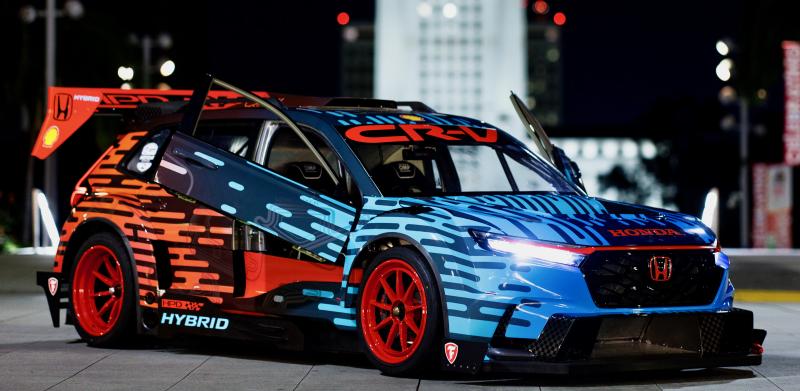 What better way to emphasize the extra “sport” of electric power than by building an 800HP, carbon-fiber, mid-engine racing version of the new CR-V?
What better way to emphasize the extra “sport” of electric power than by building an 800HP, carbon-fiber, mid-engine racing version of the new CR-V?
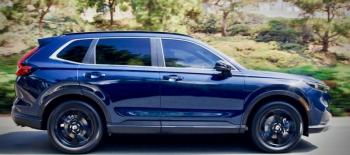 For 2023, Honda unveiled the 6th generation of the CR-V—slightly larger and much roomier, more refined, quicker and better-handling, and with “normalized” hybrid options. This color is Canyon River Blue.
For 2023, Honda unveiled the 6th generation of the CR-V—slightly larger and much roomier, more refined, quicker and better-handling, and with “normalized” hybrid options. This color is Canyon River Blue.
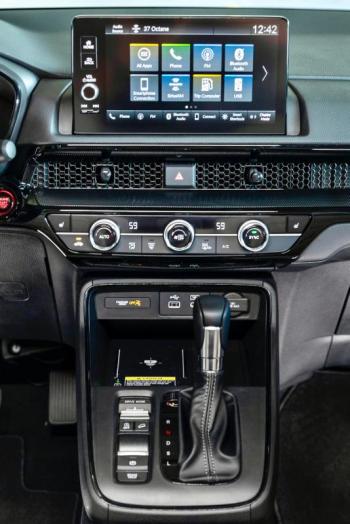 Inside, the new CR-V is pure Honda—highly space-efficient, well-sorted ergonomically, with plenty of storage spaces and featuring surfaces that look and feel good. This is the Sport Touring’s 9-inch touchscreen.
Inside, the new CR-V is pure Honda—highly space-efficient, well-sorted ergonomically, with plenty of storage spaces and featuring surfaces that look and feel good. This is the Sport Touring’s 9-inch touchscreen.
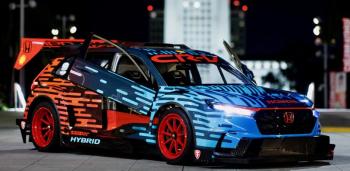 What better way to emphasize the extra “sport” of electric power than by building an 800HP, carbon-fiber, mid-engine racing version of the new CR-V?
What better way to emphasize the extra “sport” of electric power than by building an 800HP, carbon-fiber, mid-engine racing version of the new CR-V?
Is a hybrid vehicle the best of both worlds, internal combustion and battery drive, each neatly positioned to supplement the other? Or is it neither fish nor fowl, a mash-up of two technologies that’s just a bridge to a better future?
The arguments over this and the lifetime environmental impacts of manufacturing, driving and finally recycling these things will rage on, but most hybrid buyers focus on two things: How much more will it cost than a straight-up gas vehicle? And how much less gas will it burn, to save both dollars and carbon emissions?
Over 25 years or so, the cost of hybridizing cars has come down, and now Honda has taken the next step in “normalizing” hybrids by integrating them into its lineup. There are no separate CR-V Hybrid models any longer; instead, of the five trim levels of the new-for-2023 6th-generation CR-V, two—Sport and Sport Touring—are what Honda now calls two-motor hybrids.
Yes, there’s a “Hybrid” badge on the tailgate, but the emphasis here is on “Sport.” Across the automotive board, from the Ferrari SF90 to the Chevrolet Bolt, if it’s a hybrid, it’ll blast off the line faster than with just a gas engine. It’s got two propulsion systems, after all, and the electric one delivers its torque virtually instantly.
The second motor that Honda refers to, however, isn’t the gas engine; the CR-V has two electric motors, one to provide driving power while the other functions as a generator to recharge the batteries while underway.
No question, this two- (three-?) motor CR-V is “sporty”—drop the throttle and it will zip to 60 MPH surprisingly quickly. Total system output is 204 horsepower and 247 pound-feet of torque, up three horses and 15 torques from the ’22 CR-V Hybrid. The new two-motor-hybrid CR-V will now tow up to 1,000 pounds, too.
Gas-only 2023 CR-Vs, the LX, EX and EX-L, are powered by a 1.5-liter turbo Four making 190 horsepower and 179 pound-feet of torque. Some CR-V models are available with front-wheel drive; all come with the same automatic transmission, a continuously variable type. This CVT has had every last wrinkle ironed out of it—no whining, no over-revving—and it comes with shift paddles on the steering wheel.
Should anyone take their new CR-V off-road, automatic hill-descent control is now built in too, at speeds of less than 12 MPH. And in the hybrids, in Battery mode the transmission even provides a touch of the “one-pedal” driving of pure electric vehicles.
Honda’s two-motor CR-Vs are rated for up to 40 city MPG with AWD and 43 MPG with front-wheel-drive only. In about 250 miles of mostly highway driving, we averaged 31 miles per gallon—but most hybrids deliver their best fuel efficiency at low speeds, where their battery power lasts longer.
The electric motor and batteries add about 300 pounds, bringing the Sport Touring CR-V to around 4,000 pounds overall. Weight is generally the enemy of performance, but in this case not only does the electric torque overcome the added weight, but the extra mass also smooths out the ride and (presumably) drops the center of gravity slightly, for flatter and more balanced cornering. This CR-V rides with luxury-car aplomb.
For 2023, the CR-V was re-styled as well as re-engineered, and the result is a crisper, more modern-looking vehicle that also seems bigger. Commendably, however, since 2013, the CR-V has grown only some seven inches in overall length and 3.5 inches in width. But Honda is a master when it comes to maximizing interior space, and the new CR-V feels much roomier than its predecessors, as well as fancier, more refined and quieter.
The top trim levels of the CR-V are comprehensively equipped with safety systems and luxury and convenience features, yet prices have not increased dramatically. Before the $1,295 destination & handling fee, the entry-level LX starts at $28,410 while the top-end Sport Touring’s MSRP is $39,100; our sample vehicle stickered at $39,845.
According to Honda, the CR-V has been the best-selling crossover SUV in America for more than 25 years. The 2023 version seems positioned to keep that trend alive well into the future, when Honda expects fully half of them to be hybrid-drive.

